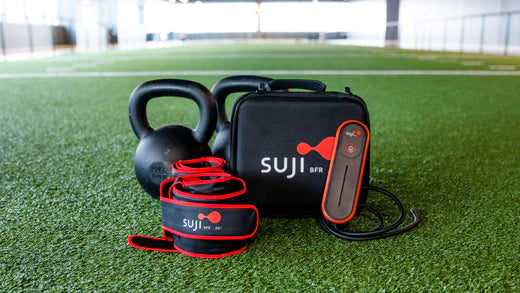Introduction:
Eccentric (ECC) hamstring strength is a key physical quality in mitigating soft tissue injury risk and improving physical performance. The most effective way to develop ECC hamstring strength is via supramaximal ECC strength training. This form of training leads to very specific neuromuscular adaptations that collectively increase the strength of the muscle during the eccentric phase of movement (for a comprehensive review see Douglas et al., 2017). However, ECC training often requires high mechanical loads and certain individuals will be contraindicated to this form of high-intensity exercise. Blood flow restriction (BFR) training has evolved as a useful training method to achieve increases in muscle mass and muscle strength using low intensity training alternatives (What is blood flow restriction training?). To the authors knowledge, there is currently no research exploring the potential of BFR training to increase ECC muscle strength. The purpose of this case study was to explore whether 6-weeks of submaximal ECC strength training could improve maximal ECC strength of the hamstring muscles in a highly trained professional athlete.Methods:
Subject characteristics:
The subject was a 23-year old professional rugby union athlete. He has a history of high grade strain injuries to his posterior cruciate (PCL), and medial collateral ligaments (MCL) in both of his knees. The PCL functions primarily to prevent posterior translation of the tibia relative to the femur, and as such, is often put under strain during many common hamstring strength exercises. These injuries have caused the subject persistent discomfort during heavily loaded open-kinetic chain (OKC) hamstring strength exercises, such as a Nordic hamstring curl, and compromised his ability to complete supramaximal eccentric hamstring loading.Intervention:
Weeks 1-3: Concentric/Eccentric loading
Occlusion pressure: 70% limb occlusion pressure (LOP)
Exercises: Seated banded hamstring curls
Sets x Reps: 30, 15, 15, AMAP (Target 15-25 reps)
Tempo: 1-0-1-0
(Eccentric phase - Transition - Concentric phase - Transition)
Rest: 60 sec
Weeks 4-6: Eccentric loading
Occlusion pressure: 70% limb occlusion pressure (LOP)
Exercises: Double leg eccentric hamstring slides
Sets x Reps: 4x20
Tempo: 3-0-0-0
(Eccentric phase - Transition - Concentric phase - Transition)
Rest: 60 sec
*Eccentric hamstring slides were completed in addition to seated banded hamstring curls during week 4-6.
The athlete has previous experience using BFR training as this was one of the training strategies implemented throughout his rehabilitation from the original injury. As such, no acclimatization period was required for this case study. BFR training was completed alongside a full pre-season training load and in conjunction with a structured strength and conditioning programme. These exercises were used as a substitute for any heavily loaded OKC hamstring exercises and were completed in the evening once all squad sessions were completed.Eccentric strength testing:
The subject completed a Nordic hamstring strength assessment as part of a routine monitoring process with the main training squad. This test was completed at the beginning of pre-season, and at the end of week 3 and 6 of the training block. Testing was completed on the Hamstring Solo - ELITE. The subject completed 3x repetitions and the maximum score was taken from each trial. The Hamstring Solo - ELITE provides unilateral force data and the maximum score was taken as the highest combined force output from both left and right legs.Results:
Over the course of the 6-week training intervention the subject achieved a 31% increase in ECC hamstring strength (Figure 1). The results observed in the present case study are similar in magnitude to those observed after 10-weeks of ECC strength training using a Nordic hamstring exercise (Bourne et al., 2017). While this case study research provides preliminary support for the use of BFR training to develop ECC hamstring strength, future research should consider the mechanisms through which we observe these changes. For example, many of the benefits of ECC training are brought about by favourable changes in muscle architecture such as an increase in muscle fascicle length. Understanding, how and why BFR training may be effective at improving performance in this particular test of ECC hamstring strength would provide useful information in dictating its application in athletic populations. Figure 1: Eccentric hamstring strength following 6 weeks of BFR training.
Figure 1: Eccentric hamstring strength following 6 weeks of BFR training.




